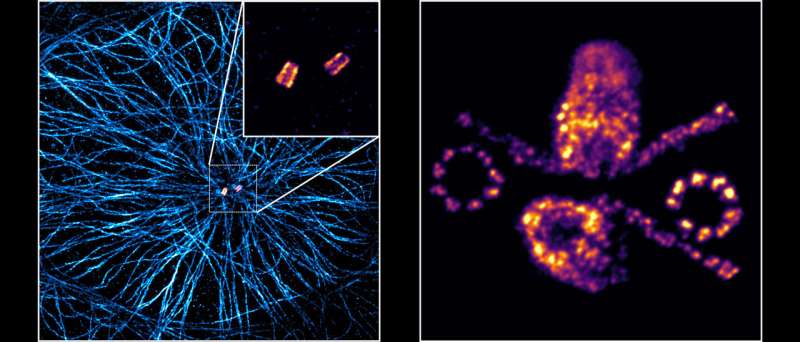Progress in super-resolution microscopy

Going deeper and deeper into cells with the microscope; imaging the nucleus and other structures more and more accurately; getting the most detailed views of cellular multi-protein complexes: All of these are goals pursued by the microscopy expert Markus Sauer at the Biocenter of Julius-Maximilians-Universität Würzburg (JMU) in Bavaria, Germany. Together with researchers from Geneva and Lausanne in Switzerland, he has now shown that a hitherto uncertain method of super-resolution microscopy is reliable.
Here we are talking about ultrastructural expansion microscopy (U-ExM). In a nutshell, it works like this: The cell structures to be imaged, in this case multi-protein complexes, are anchored in a polymer—just like decorating a Christmas tree.
Cell structures are not distorted
The interactions between the proteins are then destroyed and the polymer is filled with liquid. "The polymer then expands uniformly in all spatial directions by a factor of four. The antigens are retained and can subsequently be stained with dye-labeled antibodies," says Professor Sauer. So far, many scientists have been of the opinion that the expansion of the polymer does not proceed uniformly and produces a distorted representation in the end.
"With U-ExM, we can really depict ultrastructural details. The method is reliable," says Sauer. "And it delivers a picture that is four times higher resolved than with standard methods of microscopy."
Centrioles made the start
The research team is currently proving this in the journal Nature Methods using centrioles as an example. These cylindrical protein structures play an important role in cell division as the Würzburg biologist Theodor Boveri first described in 1888.
Centrioles were chosen for the experiment because their structure is already well known. "This enabled us to see, in comparison to electron micrographs, that U-ExM works reliably and even preserves the chirality of the microtubule triplets that make up the centrioles," explains Sauer.
Next, the JMU researchers want to use this method of microscopy to analyze cell structures of which one has not yet had such a precise picture. "These are, for example, substructures of the centrioles—the nuclear pore complexes or synaptonemal complexes. All of them are now accessible for the first time with molecular resolution by light microscopy," said Sauer.
More information: Davide Gambarotto et al, Imaging cellular ultrastructures using expansion microscopy (U-ExM), Nature Methods (2018). DOI: 10.1038/s41592-018-0238-1
Journal information: Nature Methods
Provided by University of Würzburg





















